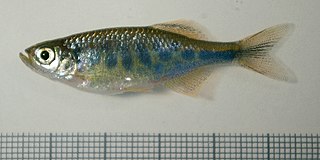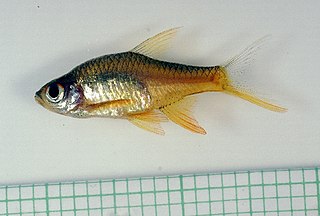
Devario is a genus of fish in the family Cyprinidae native to the rivers and streams of South and Southeast Asia. These fishes have short barbels and many species having vertical or horizontal stripes. These species consume various small, aquatic insects, crustaceans and worms, as well as, in the case of fry, plankton.
The blue moon danio is a species of cyprinid fish endemic to Myanmar. First described in 2009, they are found in small forested streams on the western slope of the Arakan Mountains in Rakhine State of south-western Myanmar; these streams are typically reduced to a series of interconnected pools during the dry season. This species has also been imported to Europe as an aquarium fish with the code names “TW02” and “Broken Line”.

Danio is a genus of small freshwater fish in the family Cyprinidae found in South and Southeast Asia, commonly kept in aquaria. They are generally characterised by a pattern of horizontal stripes, rows of spots or vertical bars. Some species have two pairs of long barbels. Species of this genus consume various small aquatic insects, crustaceans and worms.

The green labeo or mountain labeo, is a species of freshwater fish in the family Cyprinidae. It is found only in Sri Lanka, where it occurs in streams in the basin of the Mahaweli River.
Labeo lankae is a species of cyprinid fish. It is endemic to Sri Lanka.

Rasboroides vaterifloris, known as the pearly rasbora, vateria flower rasbora or fire rasbora, is a species of freshwater cyprinid fish endemic to Sri Lanka. It can be found in the shallow waters of shaded, slow-flowing clear streams with a silt substrate. It also prefers areas with plentiful leaf debris. Its diet consists of detritus and terrestrial insects. This species can reach a length of 4 centimetres (1.6 in) TL. It can also be found in the aquarium trade.

The horadandia, green carplet, or glowlight carplet, is a species of very small cyprinid fish that is found in slow-moving or still fresh and brackish water habitats in western Sri Lanka. Earlier thought to be a monotypic genus with the single species found in both Sri Lanka and India, an analysis published in 2013 showed that the Indian population should be recognized as a separate species, Horadandia brittani.

Rasboroides is a genus of small cyprinid fishes endemic to Sri Lanka. They are found in small, slow-flowing and shaded streams in the southwestern part of the island. They are essentially restricted to lowlands, although one introduced population occurs at an altitude of 980 m (3,220 ft). They are calm, social and attractively colored fish that sometimes are kept in aquariums.

The danionins are a group of small, minnow-type fish belonging to the family Cyprinidae. Species of this group are in the genera clades danio and devario, based on the latest phylo-genetic research by Fang et al in 2009. They are primarily native to the fresh waters of South and Southeast Asia, with fewer species in Africa. Many species are brightly coloured and are available as aquarium fish worldwide. Fishes of the danio clade tend to have horizontal stripes, rows of spots, or vertical bars, and often have long barbels. Species within the devario dlade tend to have vertical or horizontal bars, and short, rudimentary barbels, if present at all. All danionins are egg scatterers, and breed in the rainy season in the wild. They are carnivores, living on insects and small crustaceans.

Rohan David Pethiyagoda is a Sri Lankan biodiversity scientist, amphibian and freshwater-fish taxonomist, author, conservationist and public-policy advocate.

Rasboroides nigromarginatus is a species of freshwater cyprinid fish endemic to Sri Lanka where only known from small, shaded streams in the Atweltota region of the Kalu River basin. It can also be found in the aquarium trade.

Rasboroides pallidus is a species of freshwater cyprinid fish endemic to southwestern Sri Lanka. It is only known from shallow, slow-flowing streams in the basins of the Kalu River, Bentara River, Gin River, Polathu-Modera River and Nilwala River. It has been introduced to the Mahaweli and Walawe River basins, and is overall less threatened than the related R. vaterifloris.
Rasboroides rohani, is a species of freshwater cyprinid fish endemic to Sri Lanka where only known from shallow, slow-flowing, shady streams near Suriyakanda in the Walawe River basin. It was scientifically described in 2013, but a comprehensive review in 2018 based on morphometry, meristics and mtDNA disputed its validity, showing that it is a junior synonym of R. pallidus. The occurrence of R. pallidus in the Walawe River basin is not natural, but the result of translocations.
Schistura scripta, is a species of ray-finned fish in the genus Schistura, newly identified from Sri Lanka. It is the third species of Schistura stone loach described from Sri Lanka, the other being the widely distributed native species Schistura notostigma and endemic Schistura madhavai.
Labeo heladiva, is a species of freshwater fish in the family Cyprinidae. It is endemic to Sri Lanka. Earlier considered as the same species as Labeo dussumieri in India, recent phylogenetic and physiological differences suggest that Sri Lankan population is a distinct species.
Devario micronema, is a fish belonging to the minnow family (Cyprinidae). It is endemic to Sri Lanka. However, the validity of the species description was noted problematic by several other local ichthyologists.
The Devario annnataliae, is a fish belonging to the minnow family (Cyprinidae). It is endemic to Sri Lanka. However, the validity of the species description was noted problematic by several other local ichthyologists.
The Devario monticola, is a fish belonging to the minnow family (Cyprinidae). It is endemic to Sri Lanka. However, the validity of the species description was noted problematic by several other local ichthyologists.

Rohanixalus is a genus of tree frogs in the family Rhacophoridae native to the Andaman islands and Indo-Burma region. The genus was established in 2020 by Indian herpetologist S.D. Biju of the University of Delhi and his colleagues. The genus comprises eight species.









